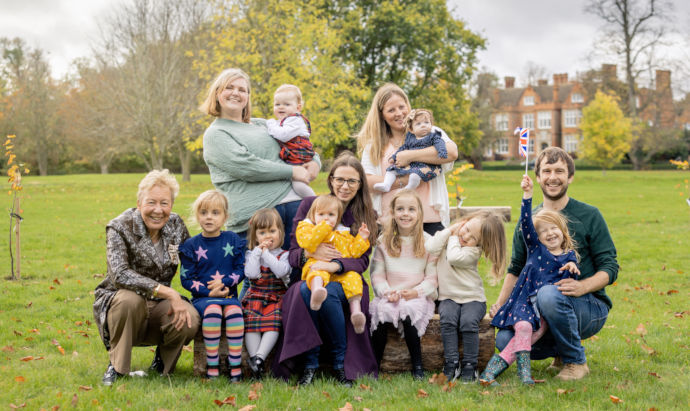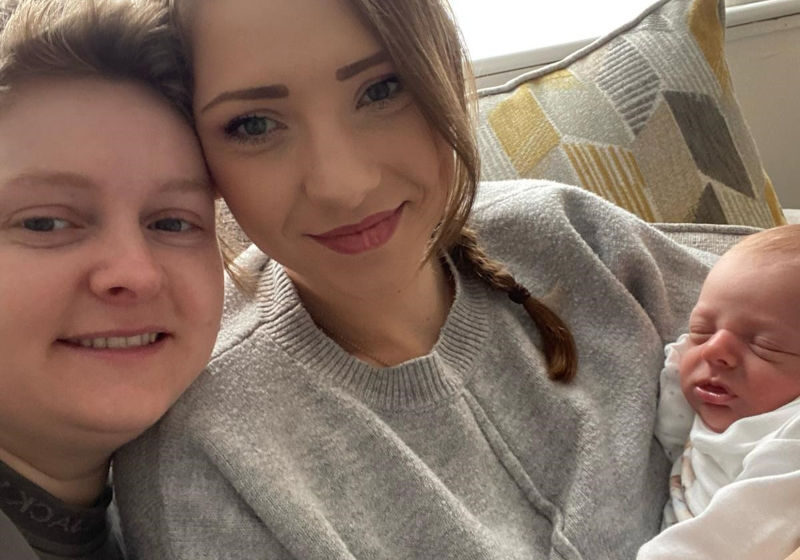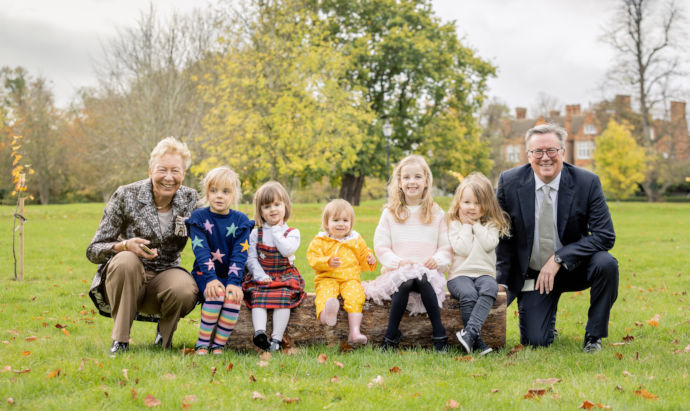Little Elizabeths plant a wood to commemorate The Queen
Five little Elizabeths were among the Bourn Hall babies who helped the Lord-Lieutenant of Cambridgeshire, Mrs Julie Spence, to create ‘Elizabeth’s Wood’ as part of The Queen’s Green Canopy initiative.
Ahead of National Fertility Awareness Week, seven lime trees have been planted at Bourn Hall Cambridge, one for each decade of The Queen’s reign, and each dedicated to a milestone in IVF – one of the greatest scientific and medical achievements made during The Queen’s reign.
Bourn Hall was built in 1602 on the site of a Norman castle and the park was landscaped by Humphry and John Adey Repton in 1817. It Is registered by Historic England for its special historic interest. When the Hall became the world’s first IVF clinic in 1980 it was described by the IVF pioneers Steptoe, Edwards and Purdy as a ‘place of sanctuary’ for those struggling with infertility.
Canopy of heart shaped leaves
Lord-Lieutenant of Cambridgeshire Mrs Julie Spence said: “I am delighted to see all these young people planting trees for the future. This group of seven lime trees being planted here today not only continues the tradition of planting lime in this Repton parkland, it also symbolises the past and ongoing fertility work here at Bourn Hall and forms part of The Queen’s Green Canopy to commemorate the Queen’s Jubilee.”
Historically, lime trees with their canopy of heart-shaped leaves have been used for shade and shelter. In folklore across Europe, they are often associated with fertility.
The small wood is part of a wider biodiversity plan at Bourn Hall that will also provide restful places for patients and staff to walk and sit. The fertility journey is a rollercoaster of emotions and woodland supports emotional wellbeing.
Body clock ticking
Elisabeth (Lizzie) Hasketh-Boston was born after IVF treatment at Bourn Hall, just a few days before her mum’s 40th birthday. Her parents, Jessica and Marc, had been trying to have a baby for ten years and Lizzie was named after Jessica’s mum who passed away suddenly.
“I really did feel as though my body clock was ticking,” says Jessica, who has PCOS, a common cause of fertility issues in women. “I had begun to think that perhaps being a mum just wasn’t going to happen for me. Over the years I used to have dreams sometimes that I had a baby and would wake up and it wasn’t true. After Lizzie was born it took me a while to realise that I wasn’t still dreaming.”
Passion for trees
Dr Mike Macnamee welcomed Mrs Spence to Bourn Hall. Mike joined the clinic 37 years ago and worked closely with Professor Edwards to develop the first hormone drugs for IVF and establish protocols to improve success rates.
He says: “Bob Edwards was a contemporary of Her Majesty and was also passionate about trees. His ambition was always to create families and so it is deeply moving that many of the little Elizabeths here today have been named after much loved mothers and grandmothers.”
Representatives from the British Fertility Society, Fertility Network UK and Professor Edwards’ family also attended the commemoration.
Bryan Woodward of the British Fertility Society, said: “Patrick Steptoe and Bob Edwards were responsible for the first successful application of in-vitro fertilisation in humans, transforming not just the lives of millions of sub-fertile people but also society and science across the world.
“When he started his work on IVF, Patrick Steptoe had the foresight to bring together colleagues interested in fertility into a professional organization designed to help them share excellence in practice and develop their nascent field. This body – the British Fertility Society – is now a thriving multi-professional association. It remains committed to the scientific and clinical ideals of its founders, and is proud to be associated with this commemoration.”
Gwenda Burns, Chief Executive of Fertility Network UK, said: “The theme for this year’s National Fertility Awareness Week is #Fighting4Fertility because fertility patients have so many things to fight for, including fair access to NHS-funded fertility treatment and IVF being recognised as necessary medical treatment. So many patients are doing that while dealing with the extreme levels of distress that infertility often brings. That’s why Bourn Hall clinic’s ‘place of sanctuary’ is so welcome. What a beautiful idea and so needed. We hope the lime trees planted here give fertility patients the emotional shelter they need to withstand the storms of infertility.”
Jenny Joy, Professor Edwards’ daughter, said on behalf of the family: “Our father’s passion for planting trees and nurturing them until they flourished took place in every location we called home, and was a big part of our life as a family from the start. They were part of the landscape of our childhood, and we can still see them today in many of these places as part of our father’s legacy, including at his farm in Dry Drayton where there are still hundreds of his trees. A tree seedling, like a human embryo, is a tiny beginning for something that needs to be nourished and cared for to grow into something unique and wonderful.”
IVF milestones
1. Professor Robert Edwards achieved the first human fertilization outside the body in 1968.
2. Patrick Steptoe established the British Fertility Society in 1972 and was the first to use a laparoscope for fertility diagnosis.
3. The world’s first IVF baby, Louise Brown, was born in 1978.
4. The UK’s first baby from a frozen blastocyst was born in 1985.
5. The first Human Fertilisation and Embryology Act was passed in 1990.
6. Bourn Hall’s first baby conceived through ICSI was born in 1995 –delivering huge advances in treating those with male infertility.
7. Bourn Hall set up the first egg sharing programme in 2002 – extending the opportunity of a family to others.

Five little Elizabeths were among the Bourn Hall babies to plant trees at Bourn Hall

Find out how can we help you
To find out more about what we do or how we can help you please get in touch
Patient reviews you can trust
Genuine experiences from real patients. See why so many trust us with their fertility care.
“We went to an open evening at Bourn Hall Wickford and came away feeling really positive about the place. The staff were really friendly and the presentation was clear about the statistics regarding success rates and live birth rates; their data was very transparent. We came away feeling like we would really be looked after.”
Katy and Leigh are parents to Charlie after IVF
Patient 2023
“We chose to make an appointment at Bourn Hall Wickford because of the favourable reviews. When we got there and met the staff they were just so lovely, making us feel welcome and explaining to us what tests would need to be done and what our options were; we just thought ‘yes, let’s get the ball rolling!”
Jess and Fran are mums to Nathan after IVF with donor sperm
Patient 2023

